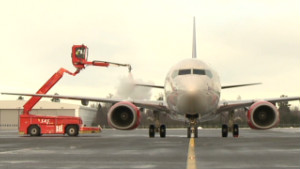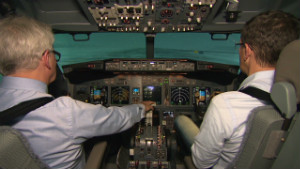 cnn weather/dam/assets/140130224942-airbus-a350xwb-cold-weather-story-top.jpg">
cnn weather/dam/assets/140130224942-airbus-a350xwb-cold-weather-story-top.jpg">(CNN) -- Who in their right mind would swap the south of France for the Canadian Arctic in the middle of winter?
A team of Airbus specialists testing the aircraft manufacturer's latest A350 XWB, that's who.
Last week a team of engineers, mechanics and test pilots from the Toulouse-based company performed various extreme-weather trials on a test plane in Iqaluit, the capital of Canada's eastern Artic territory of Nunavut.
The ground and in-air tests included operating the aircraft in temperatures reaching down to -18 Fahrenheit (-28 degrees Celsius), thrust-reversed tests with snow and a local flight test.
 Powerful antifreeze fights icy wings
Powerful antifreeze fights icy wings  Simulators help pilots master snow
Simulators help pilots master snow Like all new planes, the new model must be tested in extreme environmental condition, from freezing to intense heat.
"Coming to an extreme place means we can break everything," Airbus' head of flight operations Pedro Dias told local reporters.
Extreme cold affects various parts of an aircraft in different ways. Metals, such as steel and aluminum, contract at different rates. Lubricants may lose their viscosity, creating friction and wear issues for moving parts. Meanwhile plastic and rubber parts could become brittle.
The cold-weather tests in Canada came only days after the MSN3 test plane completed high-altitude test in Bolivia. Next stop is Qatar for hot-weather testing.
How airports beat bad weatherFor years Iqaluit, located on Baffin Island, has marketed itself as "a premier cold-weather test site."
Airbus have tested there since the 1990s, while the airport has also hosted other civilian and military aircraft makers such as Boeing, Dassault and Eurocopter to perform similar trials.
But cold weather test sites also appear in unlikely places.
In April 2010 Boeing chose McKinley Climatic Laboratory in Florida as the location for extreme-weather testing on its 787 Dreamliner.
In a test chamber the aircraft was given a "cold soak" and exposed to temperatures as low as -45 degrees Fahrenheit (-42.7 degrees Celsius) for hours.
Later, it had to endure temperatures as high as 115 degrees Fahrenheit (46 degrees Celsius), also for hours.
See: Can airships open up Arctic region?
"These tests help us establish that our customers will get airplanes that work for them in all of the climates in which they operate around the globe (and in all seasons)," said Randy Tinseth, vice president of marketing at Boeing Commercial Airplanes, in a press statement.
But extreme-weather trials are also affected by unpredictability of Mother Nature.
Initially scheduled for five days, Airbus' tests in Iqaluit were cut short, not because of an impending winter blizzard but because of a balmy temperature of -18 degrees Celsius -- too warm for the cold weather testing.
No comments:
Post a Comment